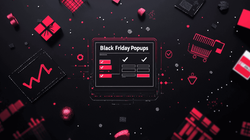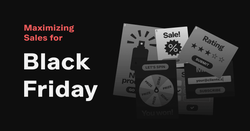
The Ultimate Checklist for Launching High-Converting Black Friday Popups
Maximize your Black Friday sales with our comprehensive checklist for creating high-converting popups. From design and copy to timing and analytics, ensure every detail is optimized for success this holiday season.
- Written by Milla Leane |
- February 13, 2025
Black Friday is one of the most significant sales events of the year, presenting a golden opportunity for businesses to boost their revenue. However, to capitalize on this, it's crucial to deploy effective strategies that capture your audience's attention and convert visitors into customers. Popups, when executed correctly, can be powerful tools in your Black Friday arsenal. This comprehensive checklist ensures that every aspect of your popup strategy is meticulously planned and implemented for maximum impact.
1. Understand Your Audience
Before designing your popup, it's essential to understand who your audience is. Analyze your customer demographics, purchasing behavior, and preferences. Utilize tools like Google Analytics and Facebook Insights to gather data on your visitors. This insight will help you tailor your popup's messaging and offers to resonate with your target audience, increasing the likelihood of conversion.
Key Actions:
- Segment your audience based on demographics and behavior.
- Identify pain points and desires that your Black Friday offer can address.
- Personalize your popup content to match different audience segments.
2. Define Clear Objectives
Determine what you aim to achieve with your popups. Whether it's building an email list, promoting a special Black Friday discount, or driving traffic to a specific product, having clear objectives will guide the design and functionality of your popups.
Examples of Objectives:
- Email Collection: Offer an exclusive discount in exchange for email sign-ups.
- Product Promotion: Highlight best-selling products or new arrivals with limited-time offers.
- Upselling and Cross-Selling: Encourage customers to add more items to their cart with bundle deals.
Tip: Ensure your objectives are SMART (Specific, Measurable, Achievable, Relevant, Time-bound) to effectively track and evaluate the success of your popup campaigns.
3. Design Eye-Catching Popups

Your popup needs to stand out without being intrusive. Use contrasting colors, high-quality images, and clear typography to grab attention. Ensure the design aligns with your brand identity and the Black Friday theme to create a cohesive user experience.
Design Best Practices:
- Color Scheme: Use colors that contrast with your website’s background to make the popup noticeable.
- Imagery: Incorporate high-resolution images that reflect your Black Friday deals or featured products.
- Layout: Keep the design clean and uncluttered. Use whitespace effectively to focus attention on key elements.
- Brand Consistency: Maintain consistency with your overall branding to ensure a seamless user experience.
4. Craft Compelling Copy
The text in your popup should be concise, persuasive, and action-oriented. Highlight the benefits of your offer, create a sense of urgency with phrases like 'Limited Time Offer' or 'While Supplies Last,' and include a clear call-to-action (CTA) that directs users on the next steps.
Copywriting Tips:
- Headline: Capture attention immediately with a strong, relevant headline.
- Body Text: Clearly explain the value of your offer. Focus on benefits rather than features.
- CTA: Use actionable language such as 'Get Your Discount,' 'Shop Now,' or 'Claim Offer.'
- Urgency and Scarcity: Incorporate elements that encourage immediate action, like countdown timers or limited stock notifications.
Example:
Headline: "Unlock 50% Off Your Black Friday Purchase"
Body: "Don't miss out on our biggest sale of the year! Shop now and save big on your favorite items before the offer ends."
CTA: "Shop Now"
5. Optimize Timing and Triggers
Determine when and how your popups appear to visitors. Common triggers include time spent on the page, scrolling behavior, or other individual user behavior. Test different timing strategies to find what works best for your audience without disrupting their browsing experience.
Trigger Strategies:
- Time-Based: Display the popup after a visitor has spent a certain amount of time on the site (e.g., 30 seconds).
- Scroll-Based: Show the popup after the visitor has scrolled through a specific percentage of the page (e.g., 50%).
- Algorithm-Based: The algorithm find the best time to show the popup based on individual user behavior and engagement patterns.
Best Practices:
- Avoid immediate popups that can annoy visitors.
- Combine multiple triggers for more precise targeting.
- Test different triggers to identify which yields the highest conversion rates.
Real-World Example: An e-commerce site found that exit-intent popups resulted in a 15% higher conversion rate compared to time-based popups, as they captured visitors' attention just as they were about to leave.
6. Implement A/B Testing

A/B testing allows you to experiment with different popup variations to see which performs better. Test elements like headlines, images, CTAs, and timing to optimize your popups for higher conversion rates. Tools like Optimizely or Google Optimize can facilitate this process.
A/B Testing Elements:
- Headlines: Try different messaging to see what resonates most with your audience.
- Visuals: Test various images or graphics to determine which attracts more attention.
- CTA Buttons: Experiment with different colors, sizes, and text for your call-to-action buttons.
- Layout: Compare different layout structures to find the most effective design.
Steps to A/B Testing:
- Identify the Goal: Decide what metric you want to improve (e.g., click-through rate).
- Create Variations: Develop different versions of your popup with varying elements.
- Run the Test: Use A/B testing tools to present different versions to different audience segments.
- Analyze Results: Determine which variation performed better based on your chosen metrics.
- Implement the Winner: Use the most effective version for your final campaign.
Case Study: Optimizing CTA Language for Increased Click-Through Rates
A HubSpot study highlights the significant impact of optimizing call-to-action (CTA) language on conversion rates. In one example, a company tested two different CTAs—"Download Now" versus "Get Your Free Guide." The "Get Your Free Guide" CTA resulted in a 22% higher click-through rate, leading to a substantial increase in lead generation during their promotional campaign.
7. Ensure Mobile Responsiveness
With a significant portion of users browsing on mobile devices, it's imperative that your popups are mobile-friendly. Ensure that they are easily readable, navigable, and load quickly on all screen sizes to provide a seamless user experience.
Mobile Optimization Tips:
- Responsive Design: Use flexible layouts and scalable images to adapt to different screen sizes.
- Readable Text: Ensure that font sizes are large enough to be read easily on smaller screens.
- Touch-Friendly Elements: Make buttons and interactive elements large enough for easy tapping.
- Fast Loading: Optimize images and scripts to reduce loading times, preventing potential drop-offs.
Testing: Regularly test your popups on various mobile devices and browsers to identify and fix any issues. Tools like BrowserStack can help simulate different environments.
8. Integrate with Your Marketing Strategy
Your popups should complement your overall marketing strategy. Integrate them with your email marketing, social media campaigns, and other promotional activities to create a unified approach that reinforces your Black Friday messaging across all channels.
Integration Tactics:
- Email Marketing: Use popups to grow your email list and send targeted Black Friday offers.
- Social Media: Promote your popup offers on social platforms to drive traffic to your website.
- Content Marketing: Align popup messaging with your blog posts and other content related to Black Friday.
- Retargeting Campaigns: Use data from popup interactions to create personalized retargeting ads.
Consistency is Key: Ensure that the messaging, design, and offers in your popups are consistent with your other marketing materials to build trust and recognition among your audience.
9. Monitor Analytics and Performance

Track key metrics such as conversion rates, click-through rates, and bounce rates to assess the effectiveness of your popups. Use analytics tools like Google Analytics to gather insights and make data-driven decisions for ongoing optimization.
Essential Metrics to Track:
- Conversion Rate: Percentage of visitors who take the desired action after viewing the popup.
- Click-Through Rate (CTR): Ratio of users who click on the popup to those who view it.
- Bounce Rate: Percentage of visitors who leave the site after viewing the popup without taking further action.
- Exit Rate: Percentage of users who leave the site from a specific page where the popup is displayed.
- Engagement Metrics: Hovers, clicks or any other actions performed on the widget.
- Engagement Metrics: Hovers, clicks or any other actions performed on the widget.
By consistently monitoring these essential metrics and utilizing advanced analytics tools like Onvocado, you can ensure that your Black Friday popups are not only engaging but also driving significant conversions and contributing to your sales goals.
Using Analytics Effectively:
- Set Up Goals: Define specific goals in your team to track popup performance.
- Segment Data: Analyze performance across different audiences across specific pages to identify trends.
- Regular Reviews: Continuously monitor and review data to identify patterns and areas for improvement.
All of the above metrics are available for detailed analysis on Onvocado's comprehensive analytics dashboard.
Some additional benefits of Using Onvocado are:
- Real-Time Data: Access up-to-the-minute analytics to make timely decisions.
- Customizable Reports: Tailor reports to focus on the metrics that matter most to your business.
- User-Friendly Interface: Easily navigate through data with an intuitive and visually appealing dashboard.
- Actionable Insights: Leverage detailed insights to refine your popup campaigns and enhance overall user engagement.
10. Ensure Compliance and Privacy
Respect user privacy and comply with regulations like GDPR and CCPA. Clearly state how you will use the data collected through your popups and provide easy options for users to opt-out. This builds trust and ensures that your marketing practices are ethical and lawful.
Compliance Steps:
- Privacy Policy: Include a link to your privacy policy in the popup.
- Data Usage: Clearly explain how you will use the collected data (e.g., for sending promotional emails).
- Consent: Implement checkboxes or consent banners to obtain explicit permission from users.
- Opt-Out Options: Provide easy ways for users to unsubscribe or opt-out of future communications.
Tools and Resources:
11. Final Pre-Launch Checklist
Before launching your popups, perform a final review to ensure everything is in place:
- Verify Links and CTAs: Ensure all links direct to the correct pages and CTAs function as intended.
- Cross-Device Testing: Test popups on different devices and browsers to confirm responsiveness and functionality.
- Optimize Loading Times: Ensure that popups load quickly without slowing down your website.
- Review Copy: Proofread all text for clarity, grammar, and effectiveness. Ensure the messaging aligns with your objectives.
- Compliance Check: Confirm that all privacy and compliance measures are properly implemented.
- Backup and Version Control: Save copies of your popup designs and settings for future reference or rollback if needed.
Launch Strategy:
- Soft Launch: Consider a soft launch to a small segment of your audience to identify any potential issues.
- Monitor in Real-Time: Keep an eye on popup performance and user feedback immediately after launch to address any problems swiftly.
Example: A Shopify study emphasizes the critical role of pre-launch testing in e-commerce success. The study highlights that identifying and fixing technical issues, such as broken links and faulty CTAs, during the pre-launch phase can significantly enhance conversion rates and prevent revenue loss during high-traffic sales events like Black Friday.
Need Help? Use Onvocado’s Black Friday Templates
If this checklist feels overwhelming, Onvocado has you covered with pre-built Black Friday-themed templates ready to use in minutes. Our extensive library includes a variety of popup widgets designed specifically for the Black Friday rush, ensuring you can launch effective campaigns without the hassle.
Look for templates tagged with "Black Friday" in our template library to find the perfect popup for your needs. Whether you're looking for interactive widgets like Spin the Wheel or straightforward Promo Codes, Onvocado offers a range of options to suit your strategy.
- Spin the Wheel: Engage users with a fun and interactive way to win discounts or prizes.
- Promo Codes: Offer instant discounts to encourage immediate purchases.
- Countdown Timers: Create urgency with timers that highlight limited-time offers.
- Exit-Intent Popups: Capture visitors' attention before they leave with special last-minute deals.
With Onvocado’s easy-to-use templates, you can quickly customize and deploy high-converting Black Friday popups that align with your brand and drive sales. Explore our Black Friday templates today and take the stress out of your holiday marketing campaigns.
Share this article
About the author

Milla Leane
Milla is a content creator and is all about creating impactful, educational content for brands. She loves experimenting with new trends and strategies, always aiming to deliver real value instead of just churning out posts. For her, it’s about building genuine connections and ensuring every piece of content has a purpose.
Discussion
No comments yet. Be the first to comment!

